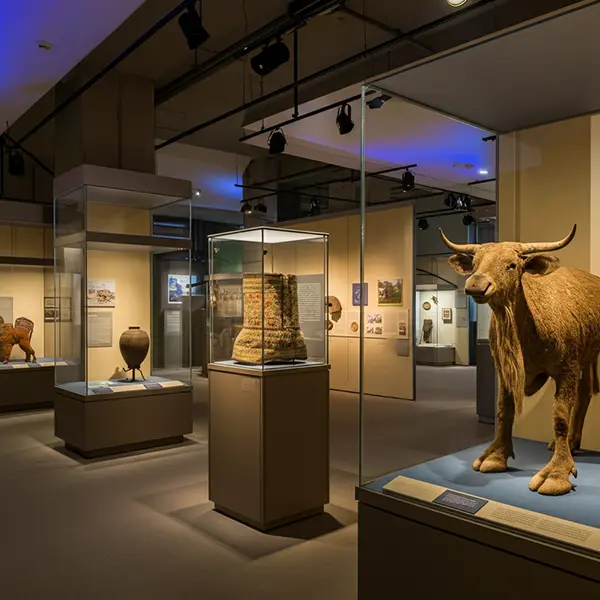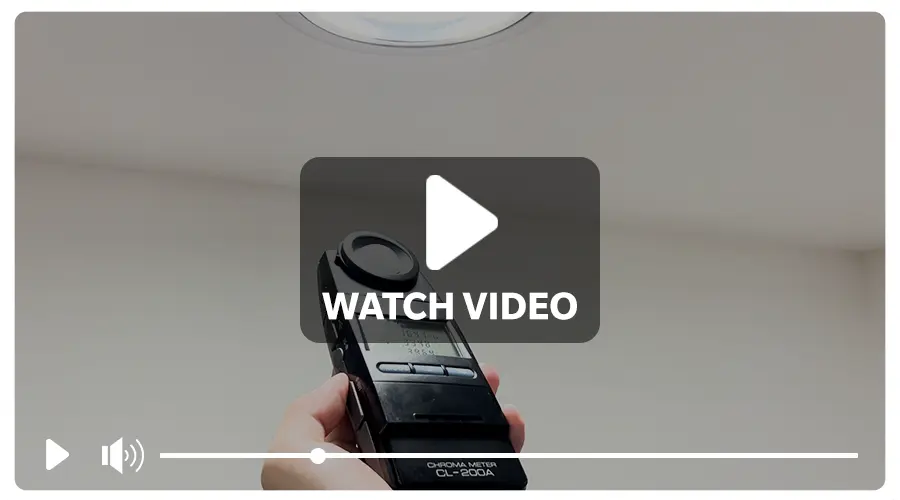บทบาทของแสงไฟบรรยากาศในพิพิธภัณฑ์และการวัดแสง

แสงสว่างในพิพิธภัณฑ์มีเป้าหมายสำคัญสองประการ ได้แก่ ส่องสว่างวัตถุเพื่อเพิ่มทัศนวิสัยและสร้างบรรยากาศที่ถ่ายทอดเรื่องราวของพิพิธภัณฑ์ อย่างไรก็ตาม แสง รวมถึงปัจจัยต่างๆ เช่น อุณหภูมิ ความชื้น และระยะเวลาการจัดแสดง เป็นสาเหตุหลักที่ก่อให้เกิดความเสียหายสะสมและมักไม่สามารถย้อนกลับคืนได้ต่อคอลเล็กชัน ดังนั้น แสงสว่างในพิพิธภัณฑ์จึงต้องสร้างสมดุลระหว่างสองสิ่งที่สำคัญที่ขัดแย้งกัน ได้แก่ การจัดนิทรรศการ (เพื่อให้เกิดความชัดเจนทางสายตา อารมณ์ และการเล่าเรื่องที่สื่อความหมาย) และการอนุรักษ์ (เพื่อลดความเสียหายจากสารเคมีและความร้อนให้น้อยที่สุด)
บล็อกนี้ได้รวบรวมหลักการจัดแสงในทางปฏิบัติ เช่น การควบคุมแสงจ้า การสร้างแสงที่ไร้เงา การจัดแสงแบบโต้ตอบหรือแบบไดนามิก แนวทางปฏิบัติที่ดีที่สุดในการวัด และผลลัพธ์จากการวัดจริงในภาคสนามที่มีการรายงานในสิ่งพิมพิ์ Lighting design in museums: Exhibition vs. preservation บล็อกนี้ได้รวบรวมหลักการจัดแสงในทางปฏิบัติ เช่น การควบคุมแสงจ้า การสร้างแสงที่ไร้เงา การจัดแสงแบบโต้ตอบหรือแบบไดนามิก แนวทางปฏิบัติที่ดีที่สุดในการวัด และผลลัพธ์จากการวัดจริงในภาคสนามที่มีการรายงานในสิ่งพิมพ์
นิทรรศการกับการอนุรักษ์ — การแลกเปลี่ยนที่สำคัญ
- แสงเป็นสิ่งจำเป็นต่อการมองเห็น แต่ทุกช่วงคลื่นของสเปกตรัม ตั้งแต่ UV ไปจนถึง Visible และ IR ต่างก็มีพลังงานที่สามารถก่อให้เกิดการเปลี่ยนแปลงทางเคมีในวัสดุได้ การตัดแสง UV ช่วยได้บางส่วน แต่พลังงานจากแสงที่ตามองเห็นได้และอินฟราเรดยังคงสร้างความเสียหายได้ (เช่น การซีดจาง การเปราะ และความร้อน)
- ความเสียหายเป็นแบบสะสมและขึ้นอยู่กับความเสี่ยง การวัดที่เกี่ยวข้องไม่ได้อ้างอิงเพียงค่าลักซ์ในทันที แต่รวมถึง ลักซ์·ชั่วโมง ตลอดช่วงเวลา (ปริมาณรังสีต่อปี) กลยุทธ์การอนุรักษ์โดยอิงตามปริมาณการรับแสงจึงแม่นยำกว่าการกำหนดเพียง “ค่าลักซ์สูงสุด” เอกสารนี้อ้างอิงแนวทางของ CIE ที่ระบุว่ากฎทั่วไปอาจยังคงทำให้เกิดปริมาณรังสีต่อปีที่สูงเกินไป หากระยะเวลาการจัดแสดงยาวนาน
- ความไวต่อแสงของวัสดุแตกต่างกัน วัสดุถูกจัดกลุ่มตามระดับความไวแสง ตั้งแต่วัสดุที่ไม่ไวแสงจนถึงไวแสงมาก โดยเฉพาะวัสดุอินทรีย์ เช่น กระดาษ สิ่งทอ สี และหมึกพิมพ์ยุคแรก มีความเสี่ยงสูงและต้องได้รับการควบคุมการสัมผัสอย่างเข้มงวดที่สุด
หลักการสำคัญของการจัดแสงบรรยากาศในพิพิธภัณฑ์
การควบคุมแสงสะท้อน
แสงจ้าที่มากเกินไปอาจทำให้สายตาล้า บดบังรายละเอียดเล็กๆ น้อยๆ และรบกวนสายตาผู้เข้าชมจากงานศิลปะ ในพิพิธภัณฑ์ การควบคุมแสงจ้าที่มีประสิทธิภาพทำได้โดย:
- โดยใช้แผ่นกระจายแสงและเลนส์ป้องกันแสงสะท้อนชนิดพิเศษ
- ติดตั้งโคมไฟในมุมเอียงเพื่อลดแสงสะท้อนบนงานศิลปะที่มีกระจกคลุม
- การใช้เทคนิคแสงไฟทางอ้อมเพื่อทำให้ความสว่างนุ่มนวลลง
การจัดการแสงสะท้อนที่เหมาะสมช่วยให้ผู้ชมสามารถชื่นชมนิทรรศการได้โดยไม่รู้สึกไม่สบายตา โดยเฉพาะอย่างยิ่งเมื่อต้องใช้เวลาอยู่ในห้องจัดแสดงเป็นเวลานาน
สามารถประเมินระดับแสงสะท้อนได้โดยใช้เครื่องวัดความสว่างเพื่อวัดความเปรียบต่างของความสว่างในสนามภาพ อัตราส่วนความสว่างที่สูงระหว่างวัตถุที่จัดแสดงและพื้นหลังสามารถบ่งชี้ถึงปัญหาแสงสะท้อนที่อาจเกิดขึ้นได้ การวัดจากมุมมองที่หลากหลายจะช่วยปรับแต่งตำแหน่งติดตั้งและการออกแบบเลนส์ได้อย่างละเอียด
แสงสว่างไร้เงา
เงาที่เข้มอาจบิดเบือนการรับรู้และบดบังรายละเอียดสำคัญ แสงที่ไร้เงาจะสร้างแสงที่กระจายทั่วพื้นที่จัดแสดง เพื่อให้แน่ใจว่า:
- งานศิลปะและสิ่งประดิษฐ์สามารถมองเห็นได้อย่างชัดเจน ช่วยให้ผู้ชมสามารถชื่นชมได้อย่างเต็มที่
- พื้นผิวจะถูกเน้นโดยไม่มีการลงเงาเข้ม
- ผู้เยี่ยมชมสามารถเคลื่อนไหวได้โดยไม่ก่อให้เกิดเงารบกวนต่อนิทรรศการ
โดยทั่วไปแล้ว ผลลัพธ์นี้จะเกิดขึ้นได้จากการใช้แหล่งกำเนิดแสงหลายแหล่ง หรือการจัดแสงแบบกระจายแสงอย่างระมัดระวังเพื่อสร้างความสว่างที่สม่ำเสมอ จะมีการวัดระดับความสว่างด้วยเครื่องวัดลักซ์มิเตอร์ ณ จุดต่างๆ ทั่วพื้นที่จัดแสดง อัตราส่วนของค่าลักซ์สูงสุดและต่ำสุดควรเป็นไปตามมาตรฐานของพิพิธภัณฑ์ที่แนะนำ เพื่อให้มั่นใจว่าความสว่างจะสม่ำเสมออย่างเหมาะสม
I
แสงไฟแบบโต้ตอบและแบบไดนามิก
ระบบแสงสว่างในพิพิธภัณฑ์ยุคใหม่นี้ผสานรวมระบบที่ปรับให้เข้ากับการเคลื่อนไหวของผู้เข้าชม การอัปเดตนิทรรศการ หรือข้อมูลสภาพแวดล้อมแบบเรียลไทม์ โซลูชันแสงสว่างแบบอินเทอร์แอคทีฟและแบบไดนามิกเหล่านี้มอบประโยชน์มากมาย ได้แก่:
- ปรับความเข้มและอุณหภูมิสีสำหรับนิทรรศการประเภทต่างๆ
- เน้นคุณลักษณะเฉพาะระหว่างทัวร์นำเที่ยว
- สร้างประสบการณ์ที่ดื่มด่ำด้วยการเชื่อมโยงกับมัลติมีเดีย
ด้วยการปรับแต่งบรรยากาศแบบเรียลไทม์ ระบบเหล่านี้ไม่เพียงแต่เพิ่มการมีส่วนร่วมของผู้เยี่ยมชมเท่านั้น แต่ยังสนับสนุนการอนุรักษ์ผลงานศิลปะอีกด้วย
ระบบไดนามิกต้องมีการตรวจสอบเป็นประจำความสว่าง–ดัชนีความถูกต้องของสี (CRI), และอุณหภูมิสีที่สัมพันธ์กัน (CCT)ด้วยเครื่องมือวัดแสงเพื่อให้มั่นใจว่าการเปลี่ยนแปลงของแสงจะไม่ให้ส่งผลเสียต่อชิ้นงาน

ตัวอย่างประกอบของอุณหภูมิสี

ตัวอย่างประกอบของดัชนีการแสดงสี
การเพิ่มประสิทธิภาพแสงสว่างในพิพิธภัณฑ์: การวัดที่จำเป็น
การให้ได้แสงสว่างที่เหมาะสมที่สุดในสภาพแวดล้อมของพิพิธภัณฑ์ต้องอาศัยการวัดพารามิเตอร์สำคัญหลายประการอย่างแม่นยำ:
- ความสว่าง (ลักซ์): รับประกันระดับแสงที่เหมาะสมสำหรับการเก็บรักษาสิ่งประดิษฐ์และความสบายตา
- ความสว่าง (cd/m²): วัดความสว่างที่รับรู้ได้จากพื้นผิวหรือวัตถุ ซึ่งมีความสำคัญต่อการควบคุมแสงสะท้อนและความสบายตาของผู้เยี่ยมชม
- SPD (การกระจายพลังงานสเปกตรัม), CCT และ CRI/Color Metrics: เมตริกเหล่านี้จำเป็นต่อการรับรองความถูกต้องของการแสดงสีและปริมาณองค์ประกอบสเปกตรัมที่เป็นอันตราย (UV/IR) การวิเคราะห์สเปกตรัมของสิ่งพิมพ์พบว่า LED สีขาวเป็นตัวเลือกที่ดีที่สุดเมื่อเทียบกับตัวเลือกทั่วไปที่ตรวจสอบ (สัดส่วน UV และ IR ต่ำมาก)
- ปริมาณการสัมผัสสะสม (ลักซ์·ชั่วโมง): ตัวชี้วัดการอนุรักษ์ที่สำคัญ ตัวชี้วัดนี้รวมระดับลักซ์ทันทีกับระยะเวลาการสัมผัส เพื่อประเมินความเสี่ยงต่อความเสียหายที่อาจเกิดขึ้น เอกสารนี้แสดงให้เห็นว่าระดับลักซ์ที่ต่ำพอสมควรอาจยังคงส่งผลให้เกิดปริมาณรังสีต่อปีที่มากเกินไป หากระยะเวลาการจัดแสดงยาวนานเกินไป
หากไม่มีการวัดพารามิเตอร์เหล่านี้อย่างแม่นยำ แม้แต่ระบบแสงสว่างที่ได้รับการออกแบบอย่างพิถีพิถันที่สุดก็มีความเสี่ยงที่จะบั่นทอนคุณภาพด้านสุนทรียะหรือความปลอดภัยในการอนุรักษ์งานศิลปะและสิ่งประดิษฐ์
ข้อมูลภาคสนามบอกอะไรเราบ้าง — การค้นพบจริงในพิพิธภัณฑ์
- การอ่านค่าในตู้จัดแสดงอาจแตกต่างกันได้มาก จุดความร้อนและความไม่สม่ำเสมอเป็นเรื่องปกติและก่อให้เกิดความเสี่ยงต่อชิ้นงานที่มีความละเอียดอ่อน
- แม้ระดับลักซ์ที่ปานกลางก็อาจส่งผลให้ได้รับแสงมากเกินไปในแต่ละปีหากจัดนิทรรศการเป็นเวลานาน การจัดการเวลาในการรับแสงจึงเป็นสิ่งสำคัญ
- การเปลี่ยนแปลงความสว่างอย่างกะทันหัน (เช่น จากห้องโถงที่สว่างเป็นห้องโถงที่มืด) อาจทำให้ผู้มาเยือนรู้สึกไม่สบายตัว การจัดโซนเปลี่ยนผ่านอาจช่วยบรรเทาปัญหานี้ได้
- โดยทั่วไปแล้ว LED จะให้ความสมดุลที่ดีที่สุด (การปล่อยรังสี UV/IR ต่ำและ SPD ที่ควบคุมได้) อย่างไรก็ตาม การตรวจสอบสเปกตรัมของโคมไฟแต่ละดวงเป็นสิ่งสำคัญ
รายการตรวจสอบการวัดผลเชิงปฏิบัติที่ต้องนำไปใช้
- จัดทำแผนที่ความสว่าง (กริดลักซ์) สำหรับแต่ละกรณี ทั้งของใหม่ใหม่/ที่แก้ไข และความสม่ำเสมอของเอกสาร
- วัดความสว่างของพื้นผิววัตถุและโซนที่อยู่ติดกันเพื่อตรวจจับแสงสะท้อน
- บันทึก SPD/CCT/CRI สำหรับทุกแหล่งกำเนิดแสงและฉากที่ตั้งไว้ล่วงหน้า เก็บสเปกตรัมไว้
- บันทึกรอบการทำงานและคำนวณลักซ์ชั่วโมงต่อปีต่อวัตถุ รวมถึงเหตุการณ์ต่างๆ
- ติดตามอุณหภูมิและความชื้นสัมพัทธ์ควบคู่ไปกับการรับแสง
คำแนะนำที่ได้รับการสนับสนุนจากหลักฐาน
- จัดการการรับแสงโดยอิงตามค่าลักซ์ชั่วโมงสะสม แทนที่จะพึ่งพาค่าลักซ์คงที่เพียงอย่างเดียว
- ใช้ LED ในกรณีที่เหมาะสม แต่ต้องตรวจสอบค่า SPD และค่าสีเสมอเพื่อให้แน่ใจว่าเหมาะสม
- ออกแบบพื้นที่เปลี่ยนผ่านแบบค่อยเป็นค่อยไปเพื่อช่วยให้ผู้เยี่ยมชมปรับตัวระหว่างพื้นที่สว่างและพื้นที่มืดได้
- เก็บบันทึกผลการวัดและตรวจสอบซ้ำเมื่อมีการเปลี่ยนแปลงใดๆ
โซลูชันการวัดแสงของ Konica Minolta สำหรับการส่องสว่างในพิพิธภัณฑ์
การจัดแสงในพิพิธภัณฑ์เป็นศิลปะที่ผสานกับวิทยาศาสตร์ โดยผสมผสานความต้องการด้านการอนุรักษ์เข้ากับประสบการณ์ของผู้เข้าชม ตั้งแต่การควบคุมแสง การนำเสนอแบบไร้เงา ไปจนถึงความสามารถในการปรับเปลี่ยนแบบไดนามิก ทุกแง่มุมของการจัดแสงที่สร้างบรรยากาศล้วนมีบทบาทต่อการรับรู้และการปกป้องนิทรรศการ Konica Minolta Sensing ผู้นำด้านการจัดแสงที่เชื่อถือได้โซลูชันการวัดแสงนำเสนอเครื่องมือความแม่นยำครบวงจรที่ออกแบบมาเพื่อตอบสนองความต้องการเหล่านี้ด้วยความมั่นใจ

จากซ้ายไปขวา: เครื่องวัดความสว่าง T-10A, เครื่องวัดความสว่าง CRI CL-70F, เครื่องวัดโครมา CL-200A, เครื่องวัดค่าสเปกโตรโฟโตมิเตอร์วัดความสว่าง CL-500A และเครื่องวัดความสว่างและสี CS-150
เครื่องวัดความสว่าง T-10Aให้การวัดลักซ์ที่แม่นยำ ให้ค่าพื้นฐานที่เชื่อถือได้สำหรับการประเมินแสงที่สม่ำเสมอเครื่องวัดความโครมา CL-200Aและเครื่องวัดความสว่าง CRI CL-70Fเพิ่มรายละเอียดพิเศษด้วยการวัดค่าลักซ์ ความเข้มของสี และอุณหภูมิสีที่สัมพันธ์กัน (CCT) CL-70F ยังวัดค่า CRI ซึ่งช่วยให้มั่นใจว่าสีจะแสดงออกมาได้ถูกต้องแม่นยำ
ชมวีดีโอ
For advanced performance, the Illuminance Spectrophotometer CL-500A provides CRI, CCT, and SPD data, enabling a comprehensive and detailed assessment of light quality to ensure optimal conditions for the presentation and preservation of artworks and artifacts.
ชมวีดีโอ
เมื่อพูดถึงการวัดความสว่าง Konica Minolta Sensing ยังนำเสนอเครื่องวัดความสว่างและสีอีกด้วยCS-150และCS-160โดยผสมผสานการใช้งานที่เป็นมิตรต่อผู้ใช้เข้ากับความแม่นยำที่โดดเด่น
สร้างสมดุลแสงที่สมบูรณ์แบบให้กับพิพิธภัณฑ์ของคุณวันนี้ติดต่อ Konica Minolta Sensingเพื่อรับคำปรึกษาฟรีและค้นพบว่าโซลูชันการวัดของเราจะช่วยให้คุณบรรลุสมดุลที่สมบูรณ์แบบระหว่างการเก็บรักษาและการนำเสนอได้อย่างไร


